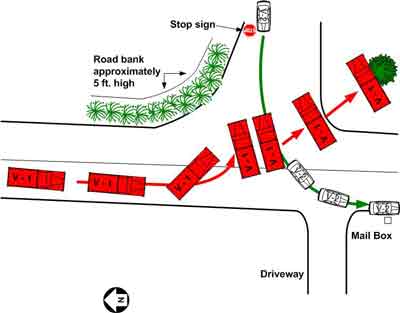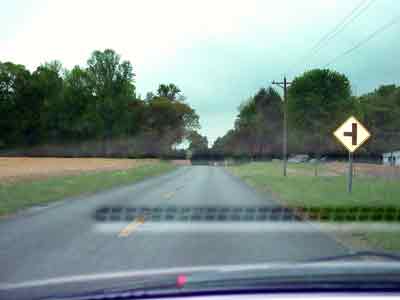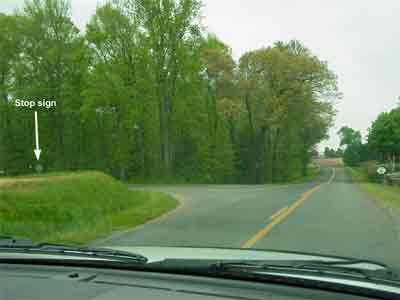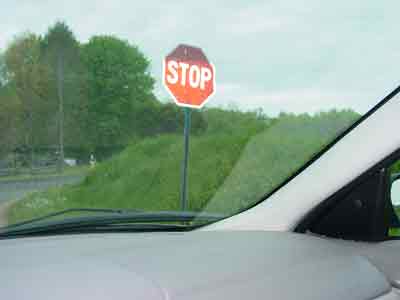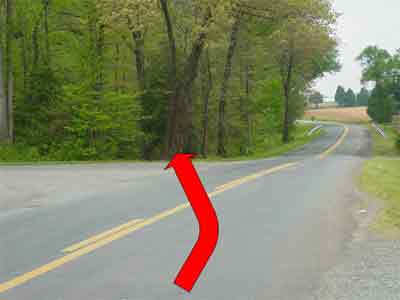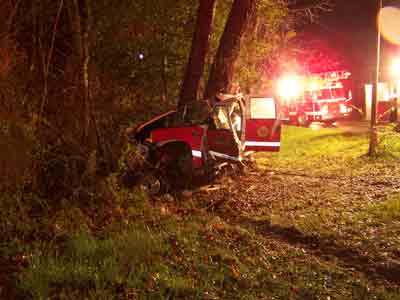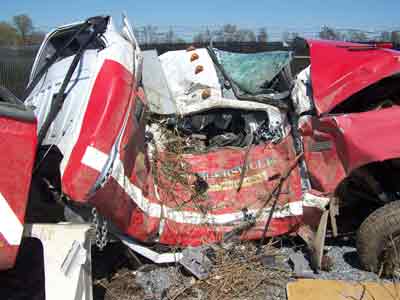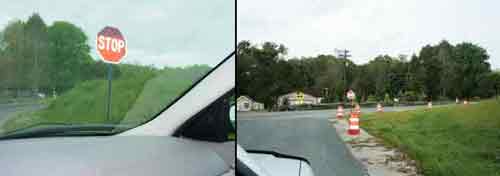Volunteer Fire Chief Dies in Motor Vehicle Incident While Responding to a Fire Alarm - Maryland
 Death in the Line of Duty…A summary of a NIOSH fire fighter fatality investigation
Death in the Line of Duty…A summary of a NIOSH fire fighter fatality investigation
F2009-12 Date Released: March 1, 2010
SUMMARY
On April 15, 2009, a 41-year-old male volunteer fire chief (the victim) was fatally injured when the vehicle he was driving skidded off the highway and struck a tree. He was driving the fire department’s response vehicle (pick-up truck) to a fire alarm when a car pulled out of an intersecting roadway to his left and across the path of his vehicle. The victim tried to maneuver his vehicle around the car, but his vehicle turned sideways and skidded down the highway. The vehicle then went off the highway and struck a tree. An eyewitness to the incident called 911 and reported the crash. Emergency medical services arrived shortly thereafter, evaluated the victim’s condition and he was pronounced dead at the scene.
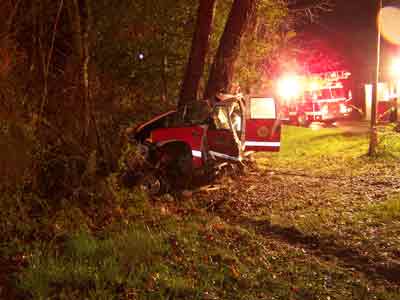
Key contributing factors identified in this investigation included vehicle speed, wet roadways, operating the vehicle without the use of a siren, and an obstructed view at the intersecting roadway.
NIOSH investigators concluded that, to minimize the risk of similar occurrences, fire departments should:
- follow the department’s written and adopted standard operating guidelines (SOGs) for apparatus/driver safety
- review, revise as necessary, and enforce standard operating guidelines (SOGs) to include specific procedures for emergency response
- train all apparatus driver/operators on defensive driver techniques
Additionally, governing municipalities (federal, state, regional, and local) should:
- ensure that adequate line-of-sight is maintained at roadway intersections, with an emphasis on routes routinely traveled by responding emergency vehicles/apparatus
INTRODUCTION
On April 15, 2009, a 41-year-old male volunteer fire chief was fatally injured while responding to a fire alarm in the fire department’s pick-up truck. On April 16, 2009, the U.S. Fire Administration (USFA) notified the National Institute for Occupational Safety and Health (NIOSH) of the fatality. On May 1-2, 2009, a safety consultant under contract with NIOSH traveled to the fire department and held a meeting with the president and acting fire chief of the fire department. An interview was conducted with the sergeant from the County Sheriff’s Office who investigated the incident. Subsequent telephone conversations were held with the State and County Roads Department engineers. The victim’s training records, photographs of the pick-up truck, vehicle maintenance log, Sheriff’s Office investigative report, certificate of death, and the fire department’s standard operating guidelines were reviewed. The incident site was examined and photographed by the investigator.
FIRE DEPARTMENT
The volunteer department has one station with 30 active volunteer fire fighters serving a population of more than 17,400 residents in a geographic area of approximately 4 square miles. The fire department had written standard operating guidelines (SOGs) which had been adopted by the department in 2001. The purpose of the SOGs for apparatus/driver safety is to establish guidelines to enhance the safety of Emergency Service Personnel responding to incidents, and its applicability applies to all Emergency Service Personnel. The fire department’s guideline number six dictates that, under wet or foggy conditions or any other hazardous road conditions, apparatus drivers should react to conditions encountered and in no case exceed the posted speed limits.1
APPARATUS/ROADWAY
The vehicle involved in the incident was the fire department’s model year 2000, Ford F350 crew cab pick-up truck which was assigned as the chief’s vehicle. Maintenance on the vehicle was provided as scheduled, and the vehicle appeared to be in good operating condition. The tire depth was reported by the local Sheriff’s Office as 9mm of tread on the left front, left rear and right front tires, and 8mm of tread on the right rear tire.
The roadway the victim was travelling on was constructed of asphalt, and was 24 feet wide and divided into two lanes (north/south) by two yellow solid lines. There were no fog lines on the sides of the roadway. The roadway travelled by the victim, although not posted, had a 50 mph speed limit. The intersecting roadway was also constructed of asphalt and its orientation was east/west. A stop sign was in place on the intersecting roadway (east/west) where the two roadways intersected. There was a 5-foot high embankment partially obstructing the view to the North from the stop sign area.
TRAINING/EXPERIENCE
The fire chief (the victim) had approximately 26 years fire fighting experience with this department, and had completed the following training: Basic Fire Program; Special Fires; Fireground Operations I (Engine Company); First Responder Basic; Fireground Operations II (Truck Company); Fire Prevention Inspections; Arson Investigation for Officers; Automatic Sprinkler and Standpipe; Fire Command I; Basic Rescue; Intermediate Rescue; Advanced Rescue; Hazardous Materials Awareness; Hazardous Materials Operations; Leadership and Supervision; Pumps; Fire Officer I Company Level Operations; Truck Company Fireground Operations; Aerial Apparatus Operator Truck Company Operations; Incident Command System; Rescue Technician Site Operations and Vehicle and Machinery Rescue; and Rescue Technician Confined Spaces. The victim had been assigned the fire department’s 2000, F350 crew cab pick-up truck in 2001. He maintained a commercial driver’s license, and during the past 8 years had responded to numerous emergency calls in the vehicle without incident.
Weather
At the time of the incident, the weather was overcast with a visibility of about 10 miles. The temperature was approximately 41o Fahrenheit and the winds were from the North at 7 mph. A light rain was falling and had been doing so since the previous day.
INVESTIGATION
On April 15, 2009, at about 1944 hours, a telephone call came into the 911 center requesting emergency assistance for a small appliance fire. The 911 center dispatched the local fire department including the fire chief (the victim). The victim, who was at his residence, left the house immediately and entered the fire department’s response vehicle (Ford F350 crew-cab pick-up truck). He started driving south on the rain-covered road and activated the red lights on the vehicle, but not the siren (see photo 1). According to the investigators from the County Sheriff’s Office, the vehicle was traveling in excess of the 50 MPH roadway speed limit as it approached an intersecting road (see photo 2). At about the same time, a compact vehicle was traveling west on the intersecting road, and approached the stop sign. Although the compact vehicle stopped at the stop sign, the view to the right (North) was somewhat obstructed by a 5-foot high embankment on the right hand side of the vehicle (see photo 3). The driver of the compact vehicle drove into the intersection across the path of the victim’s vehicle, turned South and stopped on the South-bound side of the road (see photo 3 and diagram 1).
In an attempt to avoid hitting the compact vehicle, the victim maneuvered to the left of the compact vehicle. When the victim maneuvered left, his vehicle turned sideways at about a 90o angle, and skidded down the center of the roadway. The vehicle skidded about 150 feet then left the asphalt roadway and continued to skid sideways through a grassy field (see photo 4). The vehicle skidded another 50 feet on the grassy field before hitting a large (30 inch-diameter) tree on the passenger side (see photos 5 and 6, and diagram 1). At around 1949 hours an eye witness (local homeowner) to the incident called the 911 center and reported the crash. Rescue and emergency medical service vehicles were dispatched to the incident scene. Upon arrival, the victim’s condition was evaluated by emergency responders and he was pronounced dead at the scene. Note: The victim was wearing his seat belt at the time of the incident.
CONTRIBUTING FACTORS
Occupational injuries and fatalities are often the result of one or more contributing factors or key events in a larger sequence of events that ultimately result in the injury or fatality. The NIOSH investigator identified the following items as key contributing factors in this incident that ultimately led to the fatality:
- vehicle speed
- wet roadway
- operating the vehicle without activating the siren
- obstructed view at the intersecting roadway.
CAUSE OF DEATH
The Certificate of Death listed the cause of death as multiple injuries.
RECOMMENDATIONS/DISCUSSIONS
Recommendation #1: Fire department personnel should follow the department’s written and adopted standard operating guidelines (SOGs) for apparatus/driver safety.
Discussion: The fire department had standard operating guidelines that apparatus drivers should modify driving in hazardous road conditions and in no case should exceed speed limits. In this incident, the vehicle was travelling on a wet roadway above the 50 MPH speed limit while responding to an emergency. As his vehicle approached an intersecting road, a vehicle pulled out from the intersecting road across the victim’s path of travel. The victim’s vehicle was steered left to avoid colliding with the other vehicle. At that time, the victim’s vehicle turned sideways and skidded down the road eventually crashing into a tree. Upon investigation, the County Sheriff’s Office fatal accident report indicated that speed was a contributing factor in the cause of the incident.2
Recommendation #2: Fire departments should review, revise as necessary, and enforce standard operating guidelines (SOGs) to include specific procedures for emergency response.
Discussion: Standard operating guidelines (SOGs) should be reviewed, revised as necessary, and enforced to include specific procedures for emergency response procedures. The SOGs for emergency response should cover, but not be limited to those incidents that pose a significant risk to life or property. Emergency response requires the use of all audio (siren and air horns) and visual (lights) warning devices. These devices must be in use during the entire duration of the response unless the response is downgraded to a nonemergency by a competent authority. The initial response to the following types of incidents shall be considered emergencies: a reported fire in a structure, a reported fire outside of a structure that involves the potential destruction of property or poses a risk to human or animal life, all categories of emergency medical incidents except nonlife-threatening transfers to or from a medical facility, and responses to a man-made or natural disaster involving the destruction of property and the potential for injury or death. This would include requests for assistance from other jurisdictions.3
In this incident, the victim was responding to an appliance fire within the town limits. Although emergency lights were being utilized during the response, the vehicle’s siren was not activated. As the victim’s vehicle approached the intersecting roadway, another vehicle pulled out into the path of the victim’s vehicle causing him to lose control of the vehicle and eventually collide with a tree. The driver of the other vehicle stated he could not see the lights of the emergency response vehicle because of the embankment at the stop sign, and did not hear a siren.
Recommendation #3: Fire departments should train all apparatus driver/operators on defensive driver techniques.
Discussion: Sound defensive driving skills are one of the most important aspects of safe driving. Every driver/operator should be familiar with the basic concepts of defensive driving. They include anticipating other driver’s actions, estimating visual lead time, knowing braking and reaction times, combating skids, knowing evasive tactics, and having knowledge of weight transfer. It is incumbent upon fire departments to ensure that apparatus driver/operators have periodic training on safe driving, given the risks in emergency response. This applies even with experienced drivers, such as those with commercial drivers’ licenses. Defensive driver techniques address the following basic concepts:4
Anticipating Other Drivers’ Actions
Never assume what another drivers’ actions will be – expect the unexpected. Anticipation is the key to safe driving. Always remember the following control factors:
- Aim high in steering: Find a safe path well ahead.
- Get the big picture: Stay back and see it all.
- Keep your eyes moving: Scan – do no stare.
- Leave yourself an out: Do not expect other drivers to leave you an out. Be prepared by expecting the unexpected.
- Make sure that others can see and hear you: Use lights, horn, and signals in combination.
Visual Lead Time
The concept of visual lead time refers to the driver/operator scanning far enough ahead of the apparatus for the speed it is being driven, to ensure that appropriate action can be taken if it becomes necessary. Visual lead time interacts directly with reaction time and stopping distances. By “aiming high in steering” and “getting the big picture” it is possible to become more keenly aware of conditions that may require slowing or stopping. The driver/operator is responsible for 360-degree driving.
Braking and Reaction Time
A driver/operator should know the total stopping distance for a particular fire apparatus. The total stopping distance is the sum of the driver/operator reaction distance and the vehicle braking distance. The driver/operator reaction distance is the distance a vehicle travels while a driver/operator is transferring his foot from the accelerator to the brake pedal after perceiving the need for stopping. The braking distance is the distance the vehicle travels from the time the brakes are applied until the apparatus comes to a complete stop.
Combating Skids
Avoiding conditions that lead to skidding is as important as knowing how to correct skids once they occur. The following are some of the most common causes for skids:
- Driving too fast for road conditions.
- Failing to properly appreciate weight shifts of heavy apparatus.
- Failing to anticipate obstacles (these range from other vehicles to animals); and
- Improper maintenance of tire air pressure and adequate tread depth. Tires that are overinflated or lacking in reasonable tread depth make the apparatus more susceptible to skids.
Evasive Tactics
During an evasive maneuver, the drivers’ hands should not leave the steering wheel. Drivers should not lean or sway back and forth in the seat, and they should use their arms to steer the emergency vehicle/apparatus. Drivers should look ahead of the stopped vehicle, concentrating on where they want to be. In the event of a panic stop by a vehicle ahead, emergency vehicle drivers should pass the vehicle on the left side because the civilian driver’s likely next move is to pull to the right, as is generally required by law.
Weight Transfer
The effects of weight transfer must be considered in the safe operation of emergency vehicles/apparatus. Weight transfer occurs as the result of laws of physics that state that objects in motion tend to stay in motion; objects at rest tend to remain at rest. Whenever a vehicle undergoes a change in velocity or direction, weight transfer takes place relative to the severity of the change.4
Recommendation #4: Governing municipalities (state, regional, and local) should ensure that adequate line-of-sight is maintained at roadway intersections, with an emphasis on routes routinely traveled by responding emergency vehicles/apparatus.
Discussion: Line-of-sight for motorists is one of the most important safety issues at an intersection. The ability of drivers to be able to see approaching traffic to determine if it is safe to enter the intersection is critical. Areas along the approach to an intersection and across the corners should be clear of obstructions that might block the driver’s view of approaching traffic. In this incident, line-of-sight at the intersection was obstructed by a 5-foot high embankment, and although there is no evidence this directly caused the collision, the obstructed view likely prevented the drivers from seeing each other thereby causing a delay in their reaction time.
Nationally recognized highway and transportation entities such as The American Association of State Highway and Transportation Officials (AASHTO),5 and the National Cooperative Highway Research Program (NCHRP),6 provide guidance on proper intersection design and methods to calculate safe line-of-sight distances at roadway intersections. Many state and local municipalities have developed specific ordinances outlining sight distance and roadway configuration recommendations for roadway intersections which are within their jurisdiction. Note: The local County Highway Department has made changes to the intersection where the incident occurred. The embankment has been graded down, the stop sign was moved closer to the two intersecting roadways, and a white stop bar has been painted adjacent to the Stop sign on the intersecting roadway (see before and after photographs in Photo 7 & Photo 8).
REFERENCES
- County Fire Chiefs Association [2001]. Standard Operating Guidelines. Apparatus/Driver Safety. Queen Anne’s County Government, Maryland.
- County Sheriff’s Office [2009]. Meters fatal accident report. Agency code MD0180000.
- Cook JL [1998]. Standard Operating Procedures and Guidelines. Occupational Safety and Health, SOP 403.03, pp 95-96.
- IFSTA [2000]. Aerial Apparatus Driver/Operator Handbook. First Edition. Stillwater, OK: Fire Protection Publications. International Fire Service Training Association
- The American Association of State Highway and Transportation Officials (AASHTO)external icon. [http://www.transportation.org/Pages/default.aspx]. Date accessed: September 2009. (Link Updated 1/28/2013)
- National Cooperative Highway Research Program (NCHRP)external icon [http://www.trb.org/NCHRP/Public/NCHRP.aspx]. Date accessed: September 2009.
INVESTIGATOR INFORMATION
This incident was investigated and the report written by Richard Braddee, safety consultant under contract to the National Institute for Occupational Safety and Health, Division of Safety Research, Surveillance and Field Investigation Branch, Fire Fighter Fatality Investigation and Prevention Program. An expert technical review was provided by Michael P. Dallessandro, who developed the 6 hour RESPONDSMARTexternal icon safe apparatus driver and accident reduction/prevention program and the 6 hour Volunteer and Combination Fire Department Leadership and Professional Conduct Academy www.respondsmart.com.
|
The National Institute for Occupational Safety and Health (NIOSH), an institute within the Centers for Disease Control and Prevention (CDC), is the federal agency responsible for conducting research and making recommendations for the prevention of work-related injury and illness. In fiscal year 1998, the Congress appropriated funds to NIOSH to conduct a fire fighter initiative. NIOSH initiated the Fire Fighter Fatality Investigation and Prevention Program to examine deaths of fire fighters in the line of duty so that fire departments, fire fighters, fire service organizations, safety experts and researchers could learn from these incidents. The primary goal of these investigations is for NIOSH to make recommendations to prevent similar occurrences. These NIOSH investigations are intended to reduce or prevent future fire fighter deaths and are completely separate from the rulemaking, enforcement and inspection activities of any other federal or state agency. Under its program, NIOSH investigators interview persons with knowledge of the incident and review available records to develop a description of the conditions and circumstances leading to the deaths in order to provide a context for the agency’s recommendations. The NIOSH summary of these conditions and circumstances in its reports is not intended as a legal statement of facts. This summary, as well as the conclusions and recommendations made by NIOSH, should not be used for the purpose of litigation or the adjudication of any claim. For further information, visit the program website at www.cdc.gov/niosh/fire or call toll free 1-800-CDC-INFO (1-800-232-4636).
|
This page was last updated on 02/22/2010.

